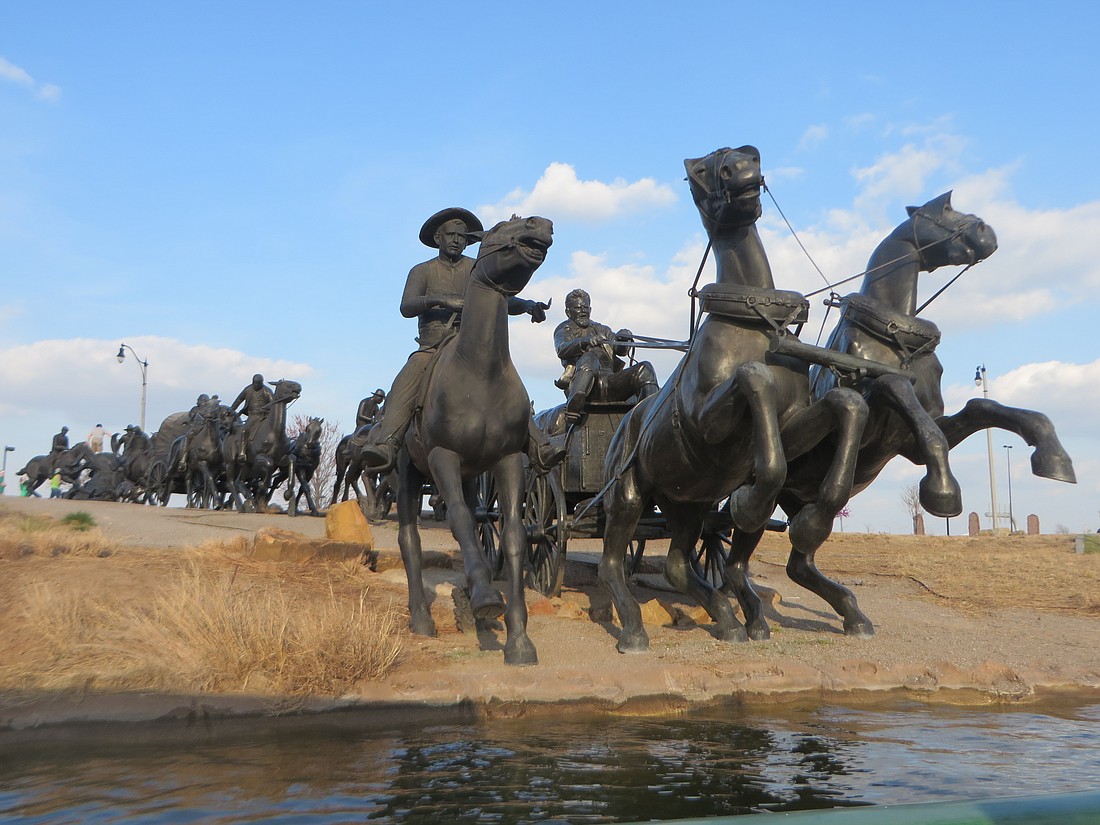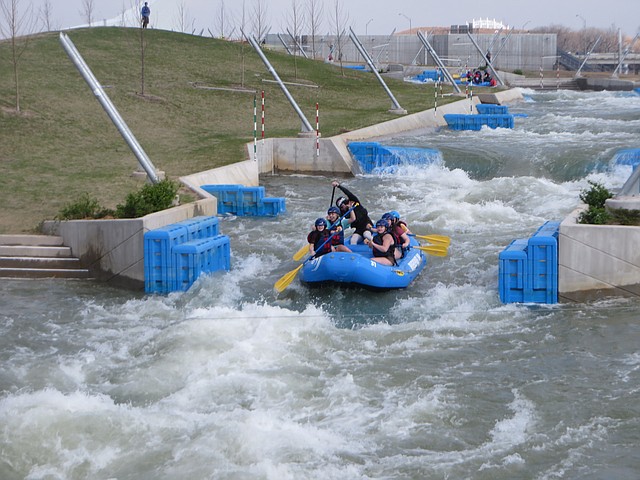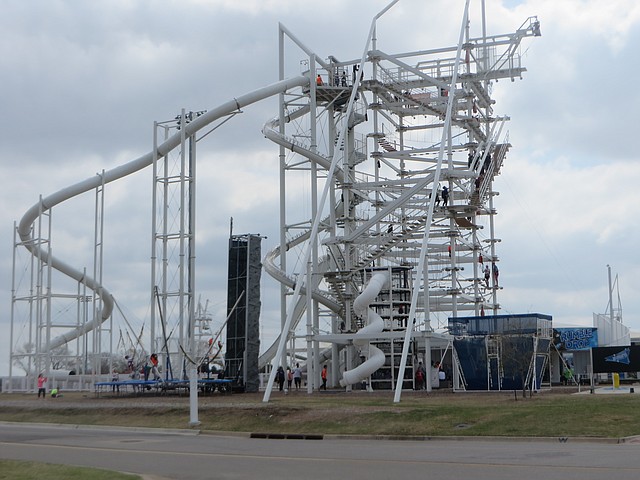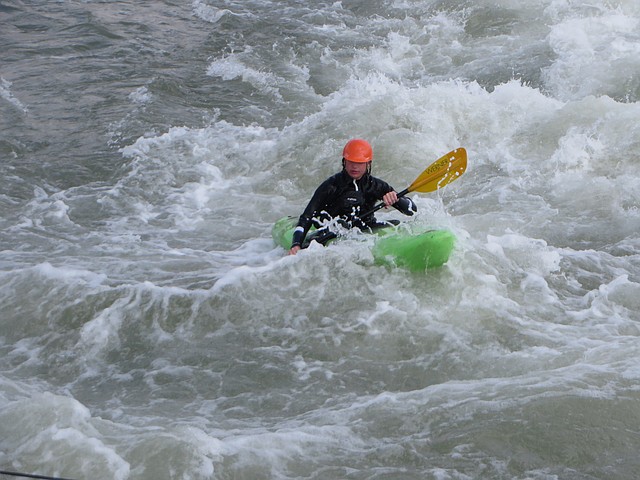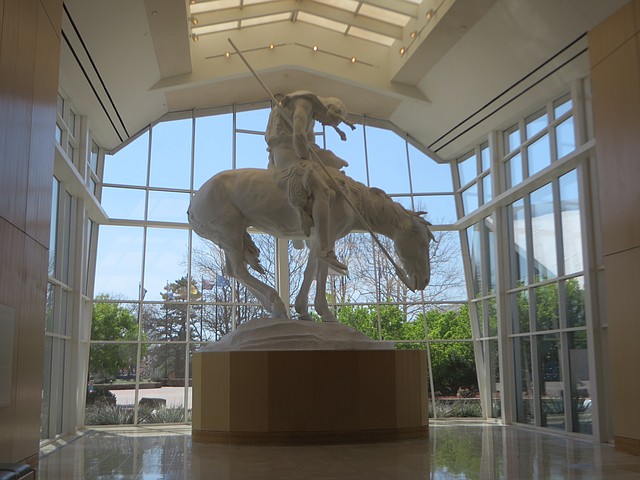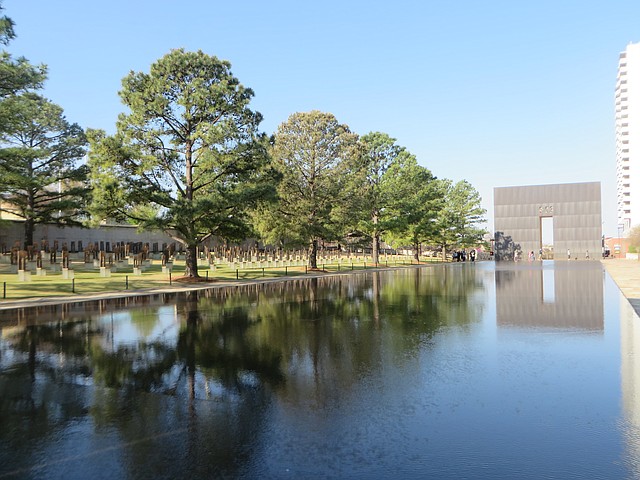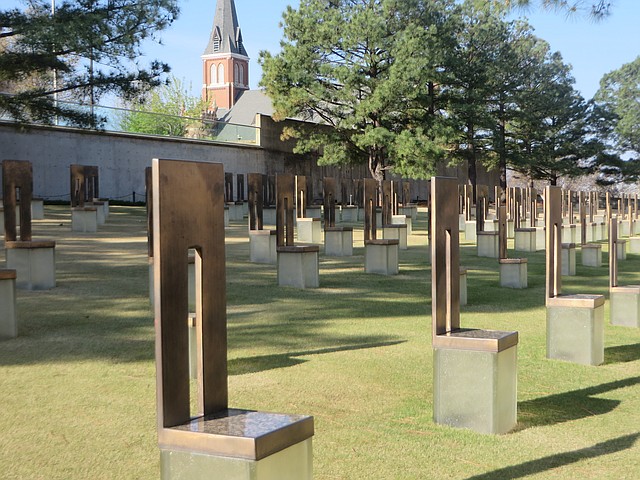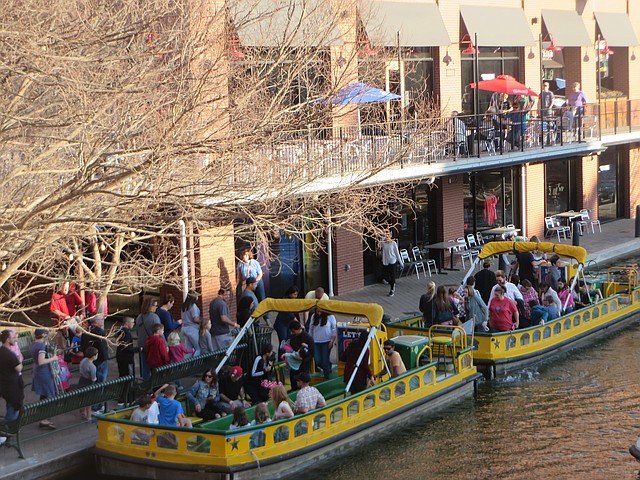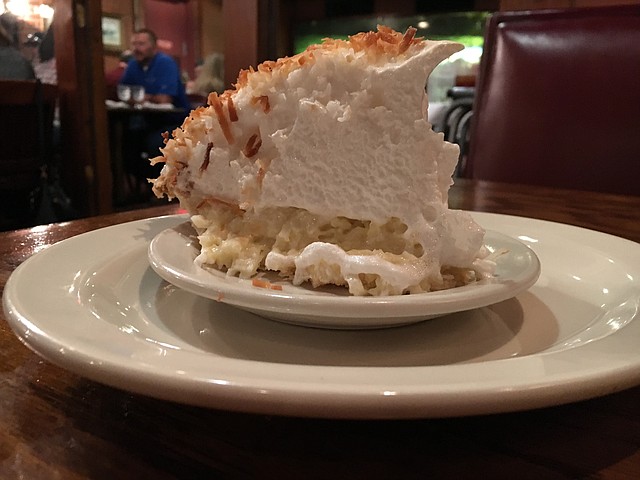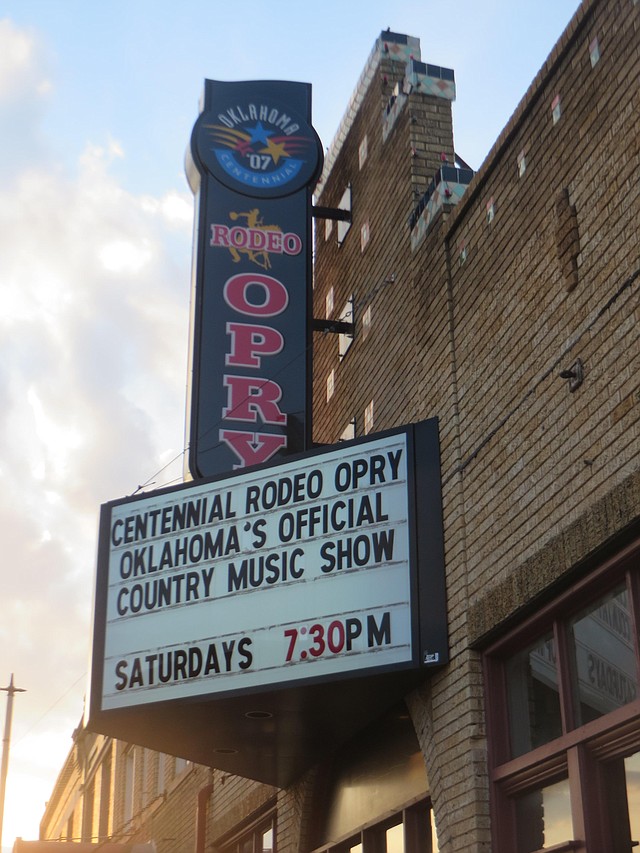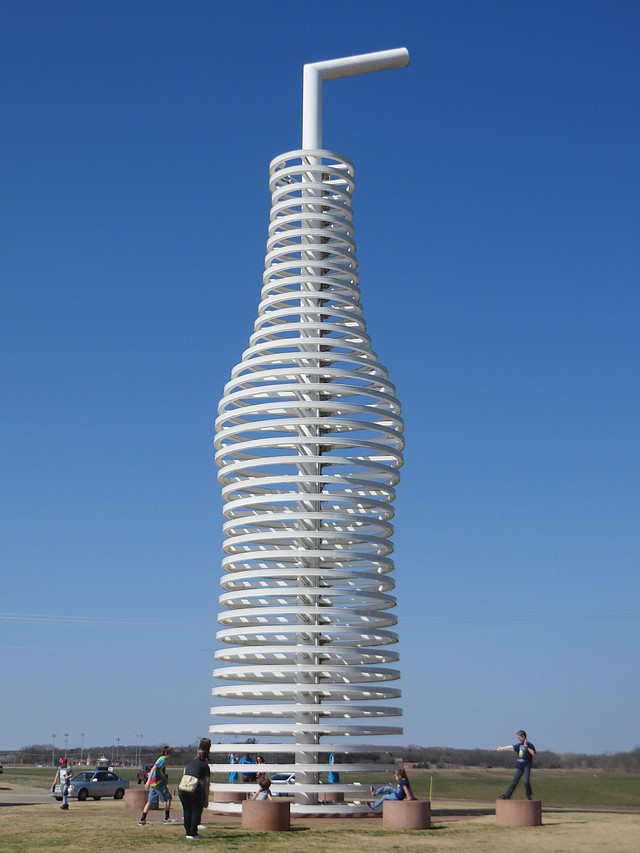Surprises abound in OKC
April 24, 2017 at 6:00 a.m.
It’s the initial ascent that provides the buildup to the exhilaration you know you’ll soon experience. At the precipice, you look down and your heart starts thumping because you know what’s going to happen next. You scream when the first shock of cold water hits and then before you can get another word out, you’re careening down a wild wave train. Your raft bounces, hits a few obstacles and spins you around, forcing you to manipulate the rapids in a rear position. The only thing to do is obey your guide’s commands, dig deep with your paddle and say a prayer you stay in the boat. The final rollercoaster of waves releases the raft into calm water and you take a deep breath before you and your fellow rafters yell, “More!”
If you’ve ever gone whitewater rafting, then the above description will sound familiar. What will come as a surprise, however, is the fact that this scenario is not taking place on one of nature’s many rivers, but rather in the middle of an urban environment – Oklahoma City to be exact!
OKC’s Boathouse District, which is located on the Oklahoma River in the city’s downtown core, is an exciting destination for anyone looking for accessible outdoor adventure. Built with a unique blend of public and private enterprise, the Boathouse District is home to Riversport Adventure Park, a landmark attraction for locals, visitors and Olympic hopefuls from all over the country. The park offers whitewater rafting and kayaking, tubing, adventure courses, zip lines, high speed slides, pump tracks, flatwater kayaking, playgrounds and miles of paved trails. There’s also a world-class, permanently lit race and training course for rowers and paddlers right on the river.
Riversport Rapids, which opened in May of 2016, has the distinction of being the only urban whitewater center in the world. This state-of-the-art facility can pump up to a whopping 492,000 gallons of water per minute, which is the equivalent to filling an Olympic size pool in eighty seconds. There are two channels or courses: international competitive and recreation. On a busy day, both are used for a variety of whitewater sports. Rapid blocks are set up as artificial boulders and can be reconfigured as needed.
Anyone can experience the Class II-IV whitewater rafting activity. You’ll first get a “trip talk,” where you’ll learn what to expect on the water and how to paddle your raft, plus some important safety information. Then you’ll be fitted for your helmet and PFD, before climbing aboard your six-person (plus guide) craft. Paddling mechanics will be reviewed with some practice time for your group to get in sync. Some folks take to paddling without much problem; others need a bit of time to fully understand that this is a joint endeavor and all must work together to help effectively navigate the raft. A conveyor belt takes you to the top of the rapids and then in an instant, you’re thrust into the churning whitewater. And yes, you will get wet – soaking wet! Typically, you’ll do several runs on the course, allowing you to catch your breath during the brief downtime.
If whitewater kayaking has always been on your bucket list, know that you can also give this sport a try. The center offers lessons to newbies, starting with the basics before trying out your newfound skills on small rapids. And for those interested in tubing or river boarding, the whitewater presents a splashing good time. Flatwater kayaking and canoeing on the nearby Oklahoma River are also available to the public.
On dry land, check out the nearby adventure course and make your way to the top of the 80-foot SandRidge Sky Trail. You’ll have the option to take a slide down, do the Rumble Drop (a controlled descent) or ride the Sky Zip. The latter is the most popular means of descent, as it runs 700 feet across the picturesque Oklahoma River and an equal distance on the return trip. Young kids will appreciate having their own designated adventure course and mini zip line.
For the bike, skateboard and skate communities, there are three world-class mountain bike/BMX courses. The Velosolutions Pump Track, for example, features seamless paved waves and is the largest of its kind in the country. It includes an integrated timing system that can connect OKC’s track with other Velosolutions pump tracks nationwide for virtual competition. The Subaru Momentum Pump Track is a fiberglass course designed with a series of berms, bumps and jumps, allowing riders to utilize gravity and body weight to “pump” rather than pedal the course. It, too, is the largest of its kind in the U.S.
While you’re in the Boathouse District, it’s hard not to notice the art and architecture present. Noted artist Owen Morrell’s Compass Rose graces the entrance to the facility, while each of the boathouses along the river are iconic pieces of architecture designed by architect Rand Elliott, Elliott & Associates. The newest, the CHK/Central Boathouse, which is owned by the University of Central Oklahoma, includes a live music venue and an art gallery.
The Boathouse District is not the only attraction that will surprise visitors to OKC. There are numerous cultural sites for history buffs, art aficionados, musicians and even devotees of cowboy lore. If some of your finest memories came from hours of entertainment with the legends of western cinema and literature, then you’ll want to head to the National Cowboy & Western Heritage Museum. Located in the rolling hills of northeast OKC (yes, there are hills, contrary to the “flat as a pancake” preconceived notions of the topography here), the museum is a world class facility where you can discover the grit, passion, courage and cultures of the American West. You’ll learn about the challenges and triumphs of the men and women who developed a way of life that has been permanently etched in our nation’s fabric. There are interactive exhibits on the American rodeo, Hollywood and the West, classic and contemporary Western art, headdresses of the American Plains, the artistry of the Western paperback and even special galleries devoted to the Western bandana, the chuck wagon and to the many different types of barb wire used for fencing on ranches. Outside is the Garden Gallery, a beautifully designed space with garden beds, walkways, fountains and more sculptures.
Also of interest is the American Banjo Museum, a 21,000 square foot facility honoring the rich history and vibrant spirit of this treasured instrument. On display are hundreds of banjos from the Old South, Minstrel Age, post WWII and the Jazz Age. Nature lovers, on the other hand, will enjoy the Myriad Botanical Gardens, an oasis in the heart of downtown. The centerpiece is the Crystal Bridge Tropical Conservatory, featuring over 2,000 fascinating species of palm trees, flowers and exotic plants from across the globe. The Oklahoma City Museum of Art, with its signature sculpture by world renowned glass artist Dale Chihuly, is a beacon for art lovers, while Science Museum Oklahoma is one of the city’s premiere educational attractions for families with hands-on science experiences, interactive exhibits, planetarium shows and more.
A must see during your visit is the Oklahoma City National Memorial Museum. Though very sobering and heart wrenching, the experience serves as a remarkable testament to the will, courage and indefatigable spirit of Oklahomans to pull together and rebuild their city after such a horrendous tragedy. The Outdoor Symbolic Memorial honors “those who were killed, those who survived and those changed forever” on April 19, 1995. It encompasses the land where the Alfred P. Murrah Federal Building once stood, capturing and preserving the place and life altering events. The Gates of Time frame the moment of destruction. The East Gate represents 9:01 a.m. on April 19th, a time of innocence prior to the attack; whereas, the West Gate represents 9:03 a.m., the exact instant when the bomb went off. The Reflecting Pool occupies what was once N.W. Fifth Street. A shallow depth of gently flowing water serves as a calming balm and peaceful setting for quiet contemplation.
Perhaps the most striking scene is the Field of Empty Chairs. Each of the 168 chairs symbolize a life lost, with smaller chairs representing the nineteen children killed. Arranged in nine rows, one for each of the nine floors of the building, they are placed according to the floor on which those killed were working or visiting. Each bronze and stone creation rests on a glass base etched with the name of a victim.
Also of note is the fence installed to protect the site of the Murrah Building. Almost immediately after the bombing, people began to leave tokens of love and hope on the fence. Over 80,000 items were collected. Today, more than 200 feet of the original fence provides an opportunity for visitors to continue to leave items of remembrance. Nearby is the Survivor Wall with over 600 names inscribed on salvaged pieces of granite from the Murrah Building lobby.
Once inside the museum, you’ll embark on a chronological self-guided tour through the story of April 19, 1995 and the days, weeks and years that followed the bombing. It is a memorable journey of loss, resilience, justice and hope. You’ll first hear the official recording of an Oklahoma Water Resources Board meeting from that day, which was held across the street from the Murrah Building. A mere two minutes into the recording, you hear the sound that forever changed our country. Ensuing galleries focus on the chaos and confusion, using artifact cases, murals, computer kiosks and helicopter footage. The rescue response and recovery efforts are detailed within the incredible stories of survivors, rescue workers, the medical community, construction volunteers and others. This is followed by a series of exhibits explaining the investigation and evidence used to piece together the case against the conspirators. Finally, justice is served. The tour leaves you not only with a thorough understanding of what happened on that terrible day and its aftermath, but with an overwhelming sense of awe and inspiration in regards to how a community rallied to remember and to memorialize.
Just east of downtown is Bricktown, OKC’s renovated warehouse district. The signature look of this historic area is red brick, as this was the most plentiful construction material available back at the turn of the century when the buildings were erected. Today, Bricktown has become the city’s hot spot for fine restaurants, clubs, galleries and shops. Water taxis helmed by humorous tour guides chug down the Bricktown Canal, a mile-long pedestrian waterway that cuts through the heart of the sector, past waterfalls and fountains, eventually ending at Centennial Crossing. There, a larger-than-life sculpture depicting the Oklahoma Land Run stands. This magnificent piece of art consists of forty-five figures portraying land run participants on their way to stake claims in the new territory.
At night, Bricktown’s restaurants and watering holes are busy. For that special meal, dine at Mickey Mantle’s Steakhouse on iconic Mickey Mantle Drive. Named after the legendary ballplayer, an Oklahoman, this restaurant is known for its array of grilled signature steaks and chef-driven menu, as well as its extensive wine list featuring hard-to-find vintages. Though meat rules at this popular eatery, seafood lovers will enjoy such dishes as Grilled Redfish with Jumbo Lump Crab or Pan Roasted Sea Pass with Lobster Risotto. Know that portions are large and you won’t go away hungry! After your meal, head to Michael Murphy’s for a rock and roll dueling piano show that’s request-driven with plenty of comedy banter and interaction between sets. It’s one of Bricktown’s favorite spots for evening entertainment.
The Stockyards District should also be on your list, especially if you want to see a little of the real West of today. Home to the world’s largest stocker/feeder livestock market, Stockyards City is the genuine thing. Browse the western wear and specialty shops lining the streets for that coveted pair of boots, cowboy hat, spurs or belt buckle. If you can’t find what you want off the shelf, there are highly skilled artisans who will be happy to custom make whatever you need. Once you’ve shopped ‘til you drop, get your sustenance at Cattlemen’s Steakhouse, Oklahoma’s oldest continually operating restaurant. A true Oklahoma tradition since 1910, Cattlemen’s is known for serving the finest cuts of beef in a relaxed, casual atmosphere, with attentive service. It’s a gathering place for all kinds of folks, from movie stars to rodeo greats, politicians and anyone with a big appetite. You’ll feel as if you’ve taken a trip back in time when you dine amid the brick walls and red vinyl leather booths. Make sure to save room for the heavenly coconut meringue pie.
On Saturday nights, stroll over to the Centennial Rodeo Opry, “Oklahoma’s Official Country Music Show.” Family-friendly productions feature talented new singers who share the stage with special guests, OKC favorites and the professional Opry house band. Famous Oklahoma artists such as Reba McEntire, Wanda Jackson and Wade Hayes not only performed at the Opry, but worked with up and coming young local talents to open the doors to their future. The Opry is an important part of Oklahoma history and its musical culture.
Worthy of a short drive from OKC is Pops Restaurant, a modern roadside attraction on fabled Route 66 in Arcadia, Oklahoma. It’s marked by a giant structure in the shape of a soda pop bottle. At 66 feet tall and weighing 4 tons, it’s hard to miss. The restaurant’s design incorporates a cantilevered truss extending one hundred feet over the gas pumps and parking area. Inside, glass walls are decorated with shelves of soda pop bottles, arranged by beverage color. The place boasts 700 different types of soda, which you can buy from the well-stocked coolers. The food is typical diner fare, but the malts and shakes are crazy good!
When it comes to accommodations, OKC has you covered. Choices abound to suit all budgets. If it’s a historical vibe you prefer, then make the conveniently located Skirvin Hilton your digs. Owner Bill Skirvin built the place back in 1911 and preceded to host a melting pot of guests, including millionaires, Indians, cattlemen and even the fabled bank robber Al Jennings. After Skirvin’s death in 1944, Dan James bought the hotel and ushered in a post-WWII golden era with a clientele of U.S. Presidents and celebrities, President Richard Nixon and Bob Hope among them. The hotel closed in 1987 due to bankruptcy and lay dormant for a number of years. Eventually, the OKC City Council bought it and had it renovated under the Hilton brand, finally reopening the place in 2007.
Today, the Skirvin boasts original architecture and several original features such as the tile floors in the lobby, the elevator doors, ceiling murals, wood floor and windows on the 14th floor and the well-known Bacchus heads that greet guests at the hotel entrance. The irony of the latter is that at the time of the property’s opening, state imposed prohibition was in effect. Skirvin, however, was fond of his adult libations and known for his wicked sense of humor. Having the Roman god of wine and intoxication smiling down upon all who entered the hotel seemed apropos in his mind!
For everything OKC: www.visitokc.com
Debbie Stone is a travel and lifestyle writer, who explores the globe in search of unique destinations and experiences to share with her readers. She’s an avid adventurer who welcomes new opportunities to increase awareness and enthusiasm for travel and cross-cultural connections. Her stories appear in a number of print publications as well as on various travel-oriented websites. Debbie is a longtime Seattle area resident, who currently resides in Santa Fe, New Mexico.
